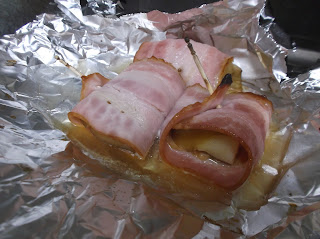Yesterday, my son came home with these:
昨日は、息子がこれらを持って帰って来ました。
Wild mukitake (left) and wild enoki (right). He bought them at the shopping center near JR Muikamachi Station.
天然のムキタケと天然のエノキです。JR六日町駅近くのショッピングセンターで買ったものです。
I put them in the vegetable compartment of the fridge. My son and I discussed what to do with these wild mushrooms.
My son's request:
One-third of the enoki: Ohitashi
Rest of the enoki and half of the mukitake: Osuimono (clear soup)
Other half the mukitake: Bacon maki (mukitake wrapped in bacon and grilled)
冷蔵庫の野菜室に入れました。息子とこれら天然のきのこをどうするか話し合いました。
息子のリクエスト:
1/3(さんぶんのいち)のエノキ: おひたし
残りのエノキと半分のムキタケ: お吸い物
もう半分のムキタケ: ベーコン巻(ベーコンを巻いて、焼く)
Today, I rinsed them under running water. I was really glad they were very clean and required little cleaning.
今日は、流水で洗いましたが、とてもきれいで、ほとんどきれいにする必要がなくて、嬉しかったです。
Wild enoki (short for enokitake or enokidake)
天然のエノキ(エノキタケ、エノキダケの略)
Other names include yuki no shita (lit. under snow) and ashi guro (lit. leg/foot black). One characteristic of this mushroom is that the stem near the root is blackish. As you can see, wild enoki is completely different from the cultured.他には、ユキノシタ、アシグロなどと言います。このきのこの特徴の一つは、根元が黒っぽいことです。見てわかる通り、天然のエノキは栽培品とはまったく異なります。
Wild mukitake
天然のムキタケ
I first boiled one-third of the enoki in a pot of boiling water for 3 minutes or so to make ohitashi.
最初に、1/3のエノキを沸騰したお湯で3分程度煮て、おひたしを作りました。
Then, without changing the water, I boiled the rest of the enoki and one half of the mukitake in the pot for 3 minutes or so. The water turned yellowish, suggesting that it contained a lot of "dashi" (lit. broth) from the mushrooms. I didn't want to throw away the goodies, so I hit upon a good idea: strain the water to remove the worms. I found some (ten or so) tiny worms in the paper towel after straining. Then, I returned the mushrooms to the pot.
お湯を変えずに、残りのエノキと半分のムキタケを3分程度茹でました。お湯は黄色ぽっくなり、きのこの「出汁」がいっぱい出ているようでした。こんな美味しいものを捨てるのはもったいないので、いい考えを思いつきました。お湯を濾して、虫を除去するということです。濾した後にキッチンペーパーに小さな虫が幾つか(10匹程度)いました。それから、きのこを鍋に戻しました。Then, I added 3 tsp of instant dashi and 1 tsp of salt, brought the water to a boil again, and poured 3 large beaten eggs slowly. The amount of water was about 1,800 ml.
次に、出汁の素を小さじ3、塩を小さじ1入れて、また沸騰させて、Lの卵を3個溶いて、ゆっくりと入れました。お湯の量は約1,800 mlです。

I wrapped the rest of the mukitake in bacon. I made seven pieces of "bacon maki" in total, three for my wife, daughter, and myself and four for my son.
残りのムキタケはベーコンで巻き、全部でベーコン巻を7個作りました。3つは妻、娘、私用、4つは息子用です。
Grilled in the 1000W toaster oven for 10 minutes.
1000Wのオーブントースターで10分焼きました。
Osumashi (clear soup)
I grilled the four bacon maki later, after my son came home at 8 o'clock in the evening.
4つのベーコン巻は、後で、息子が8時に帰って来てから、焼きました。
My son had the ohitashi with ponzu only. I would have it with katsuobushi and ponzu.息子は、おひたしをポン酢だけで食べました。私なら、鰹節とポン酢で食べます。









2 comments:
How lucky you are. Sadly around here the mushroom season is already over. A few weeks ago there was an article in our local newspaper about someone who had bought a bag full of frozen wild mushrooms at a super market and found one poisonous mushroom. Creepy. I also bought frozen wild mushrooms during winter times but I am not going to do this ever again..
Kiki: Long time, no see, how have you been?
Similar incidents happen in Japan, too, so I got to be cautious. I check each and every piece to see if it's OK. Mukitake, in particular, looks quite similar to tsukiyotake, which is poisonous.
Post a Comment